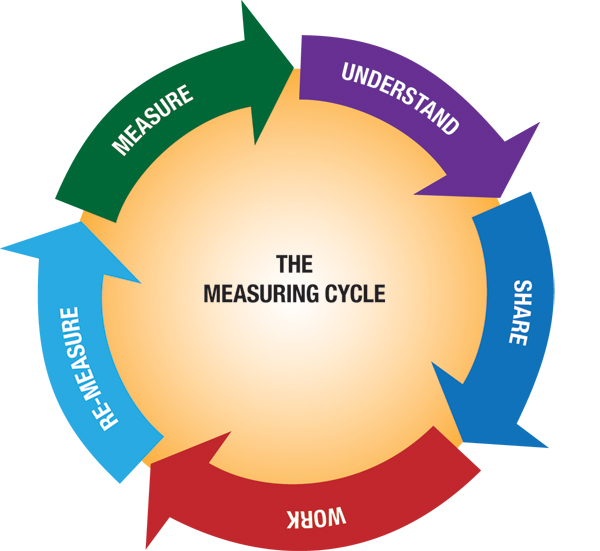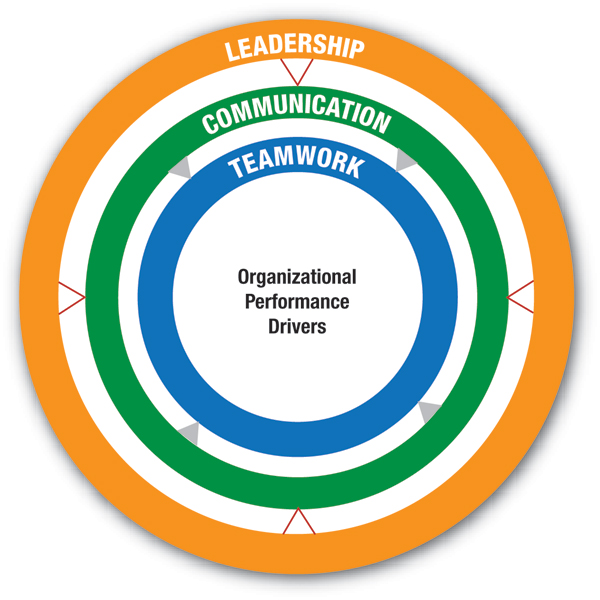How Measurement Relates to Your Business
Robert Kaplan, of Harvard University, famously states: “If you can’t measure it you can’t manage it, and if you can’t manage it you can’t change it.” A simple translation of this sentence is: If you don’t measure something, you can’t manage it, which means you won’t be able to improve it.
The intangible drivers of leadership, communication and teamwork (LCT) are key employee-performance factors that are not frequently measured. According to Kaplan’s theory, lack of measurement means these fundamental building blocks of your organization are not being managed nor improved.
Considering wages, benefits and training, what percentage of your operating budget is dedicated to personnel? One third, maybe more? How can you afford to ignore exactly how this asset is performing?
Interestingly, according to the book, Cracking the Value Code: How Successful Businesses Are Creating Wealth in the New Economy, by Boulton, Libert and Samek, only 35 percent of executives who expressed a belief in the importance of investing in their employees actually walk the talk.
Failing to measure the intangible drivers—LCT—can cost a company its competitive advantage. Too many executives become lulled into a false sense of security by merely implementing standard industry measures. The flaw in this strategy: If you only measure, manage and improve the same items as your competition, you will not differentiate yourself. Use LCT to your advantage to ensure that your company ends up on top.
The Organizational Drivers of LCT
Whether you notice an increase in employee mistakes, a decrease in customer satisfaction or a drop in retention, the root cause can be attributed to the quality of leadership at all levels of the organization; the effectiveness of internal communication; or the ability of employees to work well together.
 |
| The measuring cycle begins by measuring leadership, communication and teamwork to create a benchmark from which to track your progress. You then must work to understand the meaning behind the resulting measures and their impact on performance. Then, share the information and its meaning with the entire organization; work collaboratively to tackle organizational challenges at the root, not superficially at the symptoms; and, finally, remeasure and begin again.
|
More specifically, the cultural challenge results from a combination of all three drivers due to the synergistic relationship among them. Envision three concentric circles, with leadership in the outermost circle surrounding and impacting communication, which influences the inner circle of teamwork. While it is possible to isolate each intangible for the sake of conversation, in practice it proves impossible to disentangle them.
Consider this story about a company CEO working with an independent consultant to increase productivity. One day the CEO and consultant spied an employee raking the company’s lawn using a rake with only seven of its 12 tines. Obviously the employee’s performance was poor, leaving behind a considerable amount of leaves.
The CEO became enraged and asked, “Why would a supervisor allow an employee to work with such a poor rake?” The consultant replied, “Are you sure the supervisor is the only one to blame? To which the CEO answered, “No, of course not, you’re right—it’s my fault for not ensuring that all supervisors understand that the company strongly emphasizes the importance of their employees having the proper tools. I will meet with my managers this afternoon to make sure they understand that.”
To the CEO’s surprise, the consultant pressed further. “Isn’t there someone else who should take some responsibility?” The CEO shrugged her shoulders, not sure who else might be at fault. “What about the employee?” suggested the consultant. “Where is the employee’s responsibility to make sure he has the right tools?”
Creating a Strong Culture
The short parable above illustrates how LCT impacts performance. The consultant guided the CEO toward a cultural model described any number of s: innovative, high-performing, one with shared management, or one that provides for employee empowerment. With a slight variation in emphasis, all of these models productively blend the company’s intangibles—LCT—to create a strong culture that:
• Is greater than any one individual;
• Is aligned along a common purpose;
• Values multidirectional communication;
• Holds individuals accountable for their own behavior;
• Encourages new ideas and accepts constructive criticism; and
• Builds leadership at all levels, ensuring that it will never be without a next generation of leaders.
But other than by anecdotal evidence, how do you know when you truly have established the business culture as intended? By introducing measurement into the sustainable-culture equation. Strategically, you must provide proof; you must measure. Like the CFO who can share profit-growth figures through measurement of revenue and expenses, and the COO who can discuss the drop-in widget output as the result of counts, LCT must be quantified for two reasons:
1) Companies only value what they can measure. “The unmeasured must be measured, for if it cannot be measured, it isn’t considered of value,” notes Debra Amidon, CEO of Entovation Intl. Ltd., Wilmington, MA.
2) While a company’s financial, operations and marketing efforts are routinely included in its strategic plan, talent management and the strategies for developing the personnel required to implement the strategic plan often are absent. Without the proper people having the proper skill sets in place, a company’s strategies will not be implemented.
Measurement in and of itself will not sustain a culture. Measurement is an invaluable indicator of the direction in which a company is headed and the trends being experienced. In fact, if measurement is viewed transactionally and exclusively as a number, the most valuable component will be missed: the information that can be garnered and used to create sound actions.
The Measuring Cycle
…consists of these six steps:
1) Measure leadership, communication and teamwork to create a benchmark from which to track your progress.
2) Understand the meaning behind the resulting measures and, above all, their impact on organizational performance. For example, what are the consequences to the organization if:
• Your employees report a perception that the leaders are playing favorites?
• Your workers lack the information they need to do their jobs?
• The existence of silos prevents cross-departmental teamwork?
3) Share the information and its meaning with the entire organization, because engagement increases when the larger picture becomes clear.
4) Work collaboratively to tackle organizational challenges at the root, not superficially at the symptoms.
5) Remeasure. Use the benchmark from step 1 to quantify your progress.
6) Repeat the cycle of strengthening leadership, communication and teamwork with each iteration.
Gaining control of leadership, communication and teamwork will bring significant savings, as absenteeism is reduced, time spent on personal conflict drops and turnover decreases. These savings will be augmented by a quantifiable improvement in employee engagement, innovation and trust, all of which have been documented to provide significant increases in revenues. MF
See also: NPlusOne Consulting
Technologies: Management, Training










